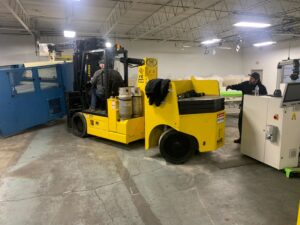Relocating a factory is a complex decision that can bring numerous advantages but also comes with potential challenges. Planning carefully and assessing various factors can help ensure a smooth transition, optimize efficiency, and reduce unexpected costs. Here, we discuss the essential factors every business should consider when contemplating a factory relocation.
Evaluating the Cost of Relocation
One of the primary factors to consider when relocating a factory is the cost involved. This includes the cost of moving equipment, potential downtime, reinstallation, and setup in the new location. Here are some of the most critical cost-related considerations:
- Direct Moving Costs
Expenses for transporting heavy machinery, equipment, and other assets can be substantial. It’s essential to compare costs from various moving companies to ensure you’re getting value for your budget. - Installation and Setup Expenses
Beyond transport, setting up machines and integrating them into the new space may require new installations, custom setups, or upgrades. These costs can be high, especially if you need specialized contractors. - Downtime and Productivity Loss
Factor in potential lost revenue during the relocation period. Even minor delays can lead to significant productivity losses, so planning a realistic timeline with a contingency budget is vital. - Local Incentives and Grants
Some regions offer tax incentives or grants for businesses relocating to boost the local economy. Researching these incentives can offset some of the relocation costs.
Incorporating Cost Analysis in Your Planning
An accurate cost estimate can streamline your relocation process, helping you allocate the necessary budget without affecting overall financial health.
Assessing the New Location’s Suitability
The location of your factory can have a lasting impact on operations, workforce availability, and overall business growth. Key considerations include proximity to suppliers, workforce availability, transportation infrastructure, and local regulations.
- Accessibility and Proximity to Key Suppliers and Markets
The location should ideally be close to your main suppliers and target markets to reduce shipping costs and lead times. Assessing the logistics network in the area can help optimize your supply chain. - Workforce Availability and Skill Level
Labor costs and availability can vary significantly by region. Relocating to an area with skilled labor can improve productivity, but areas with a limited workforce can lead to recruitment challenges and higher wage demands. - Infrastructure and Utilities
Consider whether the new location has the necessary infrastructure, such as stable power supply, water, waste management, and reliable internet connectivity. Poor infrastructure can lead to operational inefficiencies. - Local Business Environment and Regulations
Different regions have varying regulatory requirements, including environmental standards, labor laws, and zoning rules. Thoroughly understanding these regulations can prevent legal issues and compliance costs down the road.
Evaluating Location Benefits and Challenges
The right location will enhance productivity, reduce costs, and align with your long-term business goals. Conducting a detailed location analysis ensures you’re making a well-informed decision.
Planning for Equipment and Technology Needs
When relocating a factory, equipment and technology are among the most critical assets to consider. Ensuring they are safely transported and properly integrated at the new site is essential for a successful move.
- Machinery Relocation and Installation
Heavy equipment often requires specialized handling, disassembly, and reinstallation. Partnering with experienced machinery movers is vital to avoid damage and ensure smooth reinstallation. - Upgrading Technology
Relocating provides a good opportunity to assess your current equipment and technology needs. Consider whether upgrades to machinery, software, or other tools could improve efficiency in the new location. - Safety and Compliance Requirements
New locations may have different safety standards and equipment regulations. Ensuring compliance with local laws and standards will prevent legal issues and ensure a safe working environment. - Setting Up Essential IT and Communication Systems
In today’s digital age, an efficient IT and communication system is essential for smooth operations. Ensure the new location has reliable internet connectivity and that servers, networks, and communication systems are set up correctly.
Maximizing Equipment and Technology for Optimal Performance
Proper planning for equipment and technology needs can prevent costly disruptions and improve overall factory efficiency. Factor in potential upgrades to align your setup with your production goals.
Minimizing Disruption to Operations
Factory relocation can impact production timelines and create challenges in meeting customer demands. Proper planning and communication can help reduce operational disruptions.
- Creating a Detailed Timeline
Setting a realistic timeline is essential for minimizing downtime. Include contingency plans for unforeseen delays to ensure operations continue as smoothly as possible. - Involving Key Stakeholders
Clear communication with employees, suppliers, and clients is critical during relocation. Keeping everyone informed can help manage expectations and reduce disruptions. - Using Phased Relocation Strategies
A phased relocation, where certain departments or equipment are moved in stages, can help maintain partial operations and reduce productivity loss. This approach minimizes the impact of relocation on ongoing projects. - Leveraging the Expertise of a Reliable Service Provider
Partnering with a professional relocation service provider can streamline the process and reduce disruptions. Companies like Alltracon specialize in efficient factory relocations, ensuring all aspects of the move are handled seamlessly.
Alltracon: Your Trusted Relocation Partner
Alltracon offers comprehensive relocation services, including planning, equipment handling, and setup. With a proven track record in factory relocations, they help minimize downtime and ensure a smooth transition.
Conclusion
Relocating a factory is a major decision that requires careful planning and analysis. Considering the costs, assessing the new location, planning for equipment needs, and minimizing operational disruptions are all critical factors. Working with experienced service providers, like Alltracon, can make the transition smoother, helping you maintain business continuity and efficiency.












